Coronary angioplasty
Narrowed or blocked coronary artery

Coronary arteries are the blood vessels that supply oxygen-rich blood to the heart muscle. Coronary artery disease can cause plaque to build up inside the walls of the coronary arteries. Plaque is made up of extra cholesterol, calcium, and other substances that float in blood. This plaque buildup may narrow the artery and reduce the blood flow to the heart muscle. Sometimes the plaque can tear or rupture. The body tries to repair the tear by forming a blood clot over it. The blood clot can completely block blood flow through the coronary artery to the heart muscle. This will cause a heart attack. A procedure called angioplasty can widen a narrowed or blocked artery.
Step 1: During an angioplasty, a catheter is moved into the coronary artery
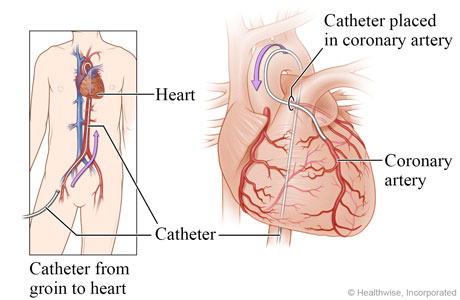
An angioplasty is done using a thin, soft tube called a catheter. The catheter is guided into the blood vessels of the heart. First, your doctor inserts the catheter into a blood vessel in the groin, arm, or wrist. A very thin guide wire is inside the catheter. Your doctor carefully guides the catheter through blood vessels to the narrowed or blocked portion of the coronary artery. Your doctor watches the movement of the catheter in the blood vessels on an X-ray screen.
Step 2: A guide wire and balloon are placed in the coronary artery
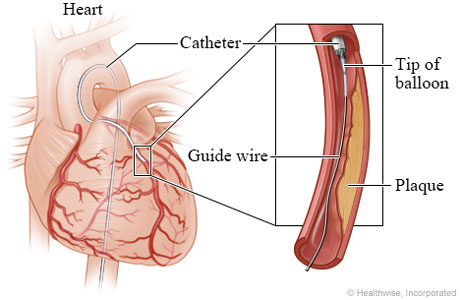
After the catheter reaches the artery, your doctor will move the guide wire farther into the narrowed or blocked portion. A small balloon is slid along the guide wire. In most cases, a small, expandable stent is placed in the artery with the balloon.
Step 3: The balloon is inflated
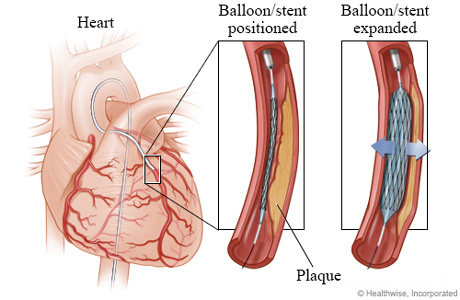
The small balloon is inflated. The balloon may stay inflated for a short time. The pressure from the inflated balloon presses the plaque against the wall of the artery, creating more room for blood to flow. The inflated balloon also expands the stent.
Step 4: The balloon, guide wire, and catheter are removed
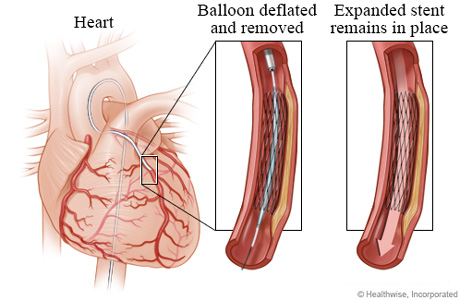
Next, the balloon is deflated. But the stent stays expanded. The stent presses against the walls of the artery and keeps the artery open. Your doctor removes the balloon, guide wire, and catheter. The stent remains in the blood vessel, allowing the blood to flow normally again.
Normal blood flow returns
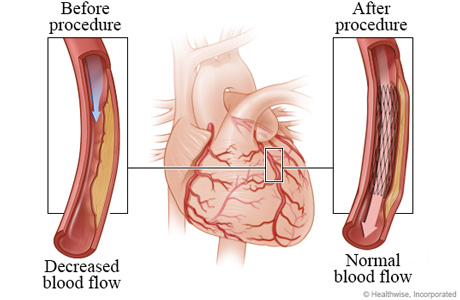
After an angioplasty, the narrowed or blocked artery is opened up and oxygen- and nutrient-rich blood flows more normally into the heart muscle.
Arteries before and after an angioplasty
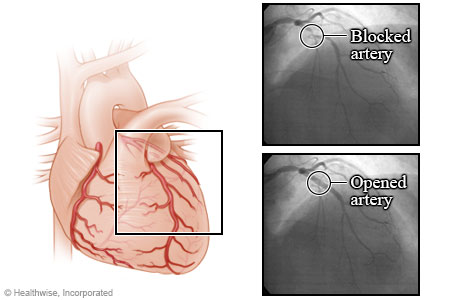
These X-rays show a blocked coronary artery before and after an angioplasty procedure. Before angioplasty, the blood flow is blocked by a narrowed artery. After the angioplasty, blood is flowing better through the newly opened artery. These X-rays are from an angiogram. An angiogram is a test that uses a special dye and camera to take X-ray pictures of the blood flow in an artery.
Current as of: October 5, 2017
Author: Healthwise Staff
Medical Review: Rakesh K. Pai, MD, FACC - Cardiology, Electrophysiology & Adam Husney, MD - Family Medicine & Martin J. Gabica, MD - Family Medicine & Robert A. Kloner, MD, PhD - Cardiology